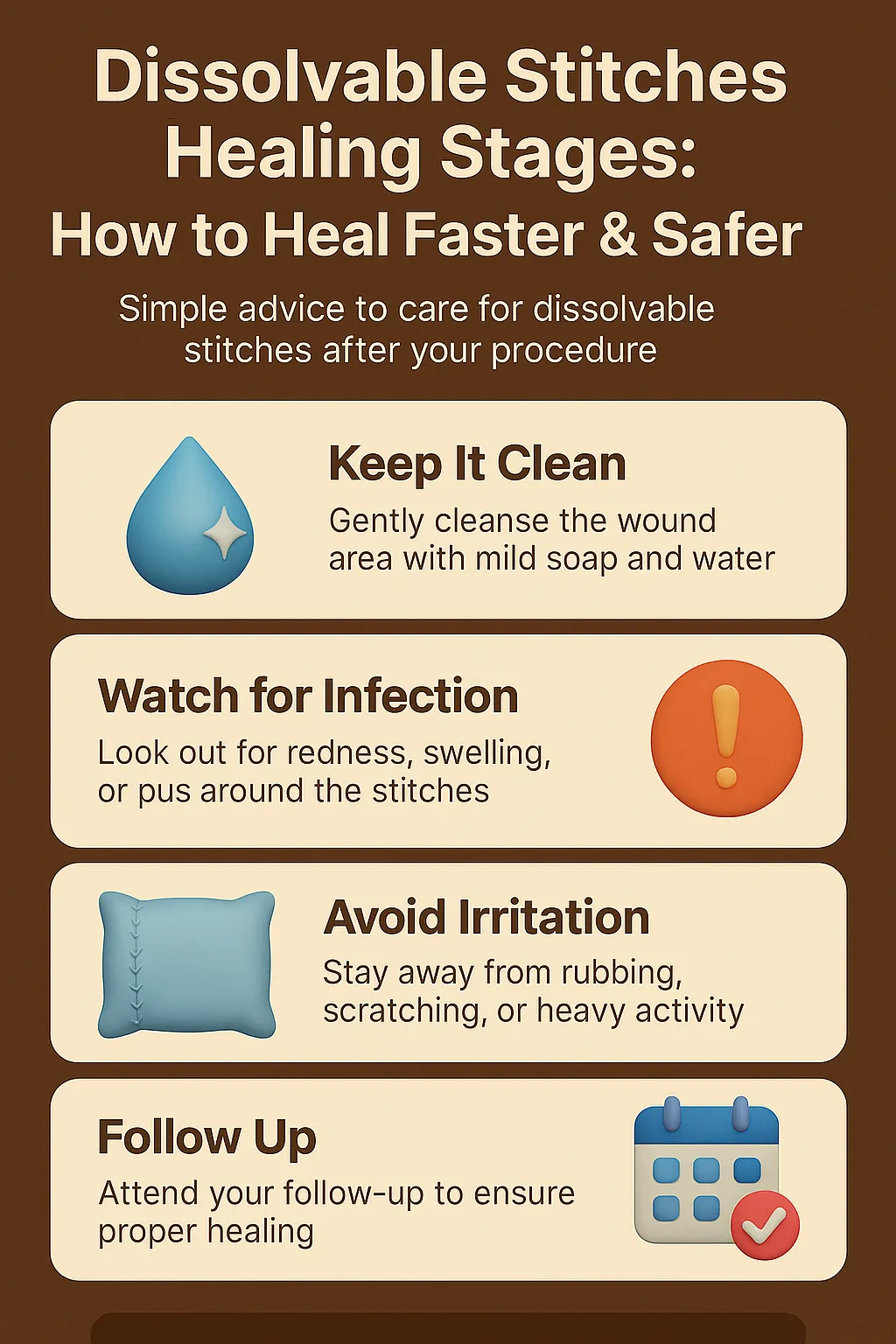Drawing on years of observing patient recoveries, this guide provides a clear, experience-based look at how dissolvable stitches work—and how to make the healing process faster and safer. Many assume healing is simply a matter of waiting for the stitches to disappear, but in reality, each stage offers specific cues and opportunities to support the body’s repair. Backed by real-life case examples, this article highlights subtle signs of healthy progress, common pitfalls that can slow recovery, and proven aftercare strategies that lead to smoother, safer outcomes during dissolvable stitches healing stages.
Top Takeaways
- Understanding each healing stage helps you act quickly if something changes.
- Proper wound care, rest, and healthy habits make recovery faster and safer.
- Patient education can reduce complications by up to 40%.
Stages of Healing for Dissolvable Stitches
Dissolvable stitches, or absorbable sutures, are designed to naturally break down as your wound heals—no removal needed. Recovery often follows these stages:
- Initial Stage (Days 1–3): Mild swelling, redness, and tenderness are common as the body begins repair. Stitches keep tissue in place during early healing.
- Early Healing (Days 4–7): Swelling lessens, and new tissue begins forming. Stitches remain but may feel looser as the wound strengthens.
- Mid-Healing (Weeks 2–3): Stitches begin to soften and absorb. Mild itchiness may occur as the skin regenerates.
- Final Stage (Weeks 4–6+): Most stitches dissolve, leaving a maturing scar that will continue strengthening for months.
Faster & Safer Tip: Keep the wound clean, follow your surgeon’s instructions, and avoid activities that could pull on the stitches.
"From my experience, faster and safer healing isn’t about rushing—it’s about understanding what each stage should look like, making informed choices, and stepping in early when something seems off."
Case Study & Real-World Insights
Case Study: Rapid Recovery After Shoulder Surgery
- Procedure: Arthroscopic shoulder repair with dissolvable stitches.
- First 72 hours: Mild swelling and redness—healthy signs.
- Day 5: Inflammation eased, new tissue visible.
- Week 2: Stitches softened; patient began light rehab under guidance.
- Week 4: Stitches dissolved; scar nearly flat.
- Keys to success: Careful wound cleaning, no overuse, and gentle mobility exercises once cleared.
Example: Slowed Healing from Overexertion
- Procedure: Abdominal surgery with dissolvable stitches.
- Mistake: Heavy lifting resumed one week post-op.
- Result: Wound partially reopened, delaying recovery by about 3 weeks.
- Lesson: Even strong stitches can’t protect against premature strain.
Supporting Statistics
- Infection Risk: About 157,500 surgical site infections occur yearly in the U.S.; half are preventable (CDC – Surgical Site Infection Prevention).
- Pre-Op Activity Benefits: Walking 7,500+ steps daily before surgery lowers complication risk by 51% (American Academy of Orthopaedic Surgeons – Preparing for Surgery).
- Hospital Programs: Enhanced recovery protocols in over 300 hospitals reduced complications and shortened stays (AHRQ – Enhanced Recovery After Surgery).
Key Insight: Faster and safer healing requires preparation, prevention, advance wound care, and consistent aftercare.
Final Thought & Opinion
Healing with dissolvable stitches is an active process, not a passive wait. The fastest and safest recoveries I’ve seen come from patients who respect the healing timeline, follow care instructions, and make smart daily choices. When you understand each stage and protect your wound, you not only heal well—you heal with confidence and fewer setbacks.
Next Steps
- Follow your surgeon’s plan – Every instruction matters.
- Monitor daily – Watch for normal healing patterns and early warning signs.
- Support your body – Eat nutrient-rich foods, stay hydrated, and keep light activity if approved.
- Avoid strain – Skip heavy lifting or stretching the wound.
- Attend follow-ups – Ensure healing is on track.
Act early – Contact your provider if something feels wrong.
Frequently Asked Questions
How long do dissolvable stitches take to dissolve?
Most dissolve naturally within 4–8 weeks, but the exact timeline depends on the type of suture, the wound location, and your body’s healing speed.
What can I do to heal faster and safer with dissolvable stitches?
Follow your surgeon’s aftercare instructions, keep the wound clean, avoid heavy activity, eat a nutrient-rich diet, stay hydrated, and attend all follow-up appointments.
What are the normal stages of healing for dissolvable stitches?
- Initial (Days 1–3): Swelling, redness, tenderness.
- Early (Days 4–7): Less swelling, tissue growth.
- Mid (Weeks 2–3): Stitches soften and begin absorbing.
- Final (Weeks 4–6+): Stitches dissolve, scar strengthens.
What warning signs mean my stitches might not be healing properly?
Contact your doctor if you notice worsening redness, swelling, severe pain, bleeding, pus, foul odor, or stitches that last well beyond the expected timeframe.
Can I exercise while my dissolvable stitches heal?
Light walking may be fine if approved by your doctor, but avoid heavy lifting, stretching the wound, or high-impact workouts until cleared to prevent reopening or slowing healing.
When following the guidance in dissolvable stitches healing stages: how to heal faster & safer, maintaining a clean environment plays a crucial role in preventing infection and promoting optimal recovery. Using high-quality filtration solutions, like the 20x24x4 Air Filters, helps reduce airborne dust, allergens, and bacteria that could compromise wound healing. Professional services such as the Air Duct Repair Company ensure your HVAC system operates efficiently, further improving air quality. Reliable options, including the 20x25x6 Replacement for Aprilaire Space Gard, the 14x14x1 MERV 11 Pleated HVAC AC Furnace Air Filters 4-Pack, and the 20x25x6 Air Filter on eBay, offer added protection by keeping indoor air cleaner. Pairing a safe, low-contaminant environment with consistent aftercare routines can make the healing process faster, safer, and more comfortable.







